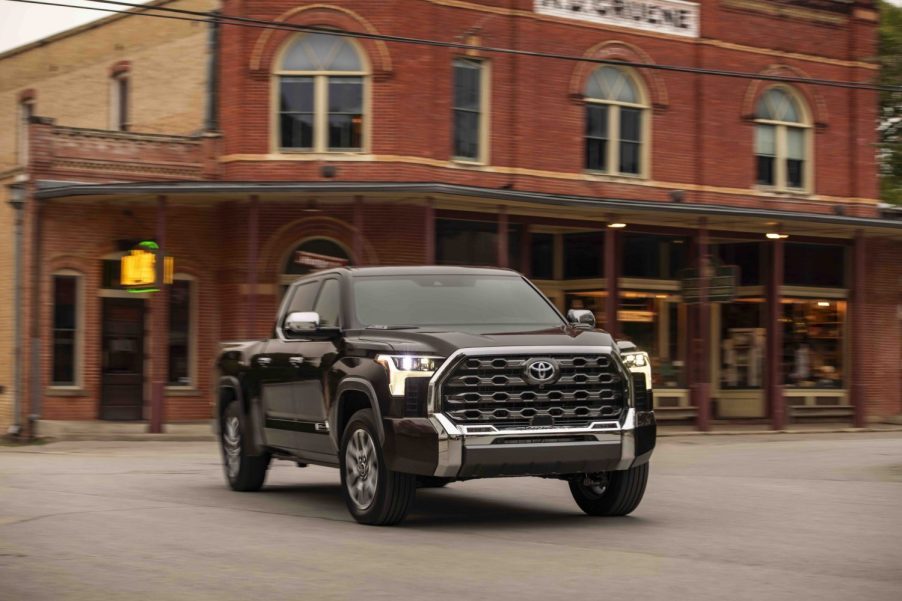
Why Doesn’t the Hybrid Toyota Tundra Have a Lithium-Ion Battery?
Many EV and hybrid enthusiasts believe that Lithium-ion (Li-ion) batteries are superior to Nickel Metal Hydride (Ni-MH) batteries. But the truth is a bit more complicated. Toyota may have several good reasons for assembling its hybrid Tundra pickup truck drivetrain–the i-FORCE MAX–with a 288-volt NiMH battery: better lifespan in extreme temperatures, lower cost, and a proven technology with a reliable supply chain.
Is Toyota being cheap by using a nickel battery in the hybrid Tundra?
Toyota probably spends less money on the NiMH battery under the rear seat of its hybrid Tundra than Ford spends on the Li-ion battery installed beneath the bed of its hybrid F-150 PowerBoost. What’s more, Toyota charges $3400 to upgrade your Tundra with the hybrid option; Ford charges between $2,500 and $4,995 to add the PowerBoost to your F-150–depending on the trim level you start with.

The two drivetrains offer nearly identical power outputs. But while the 2WD F-150 PowerBoost offers 25 city/25 highway MPG (25 combined), the 2WD Tundra i-FORCE MAX is only rated for 20 city/24 highway MPG (22 combined). The 4WD F-150 PowerBoost earned 23 MPG across the board while the Tundra competitor fell to 19 city/22 highway MPG (20 combined).
Choosing the Ford will net you higher fuel savings. This dramatic difference in fuel efficiency may be, in part, due to the Ford F-150 PowerBoost’s 1.5 kWh Li-Ion battery pack.
Why did Toyota choose a nickel metal hydride (NiMH) battery for the hybrid Tundra?
Toyota officially calls the 288-volt NiMH battery in its Tundra hybrid “proven and reliable.” This is undoubtedly a time-tested technology. Toyota may have also chosen it in an effort to keep the cost of its trucks low, for a longer lifespan in extreme climates, and to ensure no future supply chain issues.

Ford sells many more F-150s than Toyota sells Tundras. For Toyota to pay off the i-FORCE MAX’s research and development cost, it may be forced to charge more per unit than Ford. If this is the case, going with a nickel battery may be one of its only options for making the i-FORCE MAX competitive.
Sometimes, securing a Li-ion battery is not as simple as paying more. Industry experts warn that increased EV production is leading to a lithium shortage that could make future batteries twice as expensive. If the lithium shortage gets bad enough, it might interrupt the production of many EVs and hybrids. Toyota engineers a NiMH version of every generation of its Prius hybrid–for example–so it can quickly pivot between battery chemistries to circumvent any future supply chain issues.
Finally, extremely cold and extremely hot climates rapidly degrade Li-ion batteries’ capacity. NiMH batteries do not have the same weakness. This is one reason that Toyota manufactures its AWD Prius, many destined for snowy areas, with NiMH battery pack–according to Torque News. It may have made a similar choice for the Tundra.
What are the weaknesses of an NiMH battery pack?
Due to the chemistry of an NiMH battery pack, it requires more space–and weight–to pack in the same amount of power. In addition, it is slower to charge up and slower to discharge. This makes it a non-starter for most EVs and may limit its effectiveness in large hybrids.

The large size and increased weight of an NiMH battery may not be a huge deal in a full-size pickup truck. If you add the i-FORCE MAX option to a Tundra, Toyota installs a sealed nickel metal hydride under the rear seat.
The NiMH’s charging limitations, however, may be a larger drawback. When you tap the hybrid Tundra’s brakes, the motor/generator between its turbocharged V6 and ten-speed automatic helps slow the vehicle while using the momentum to recharge the battery. But the NiMH can only soak up so much power. Then when you hit the gas, the motor will accelerate you to 18 mph–but again, there’s a limit to how much juice it can pull from the nickel battery.



